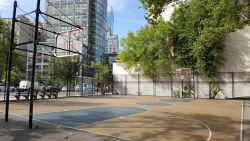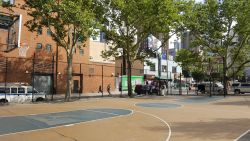Grand Canal Court
Grand Canal Courts
The name of this park salutes the New York City streets to its north and south. The name also refers to the extraordinary manmade waterways in China and Italy. New York’s Grand Street was originally laid out prior to 1766 and was known as the thoroughfare to Crown Point (now Corlears Hook). The street earned the name "Grand" due to its remarkable width of one hundred feet. In 1818 the Common Council resolved that a market house be constructed on Grand Street between Ludlow and Essex Streets to serve the needs of the families of local working men. Grand Street has served as a commercial destination ever since.
Canal Street takes its name from the forty foot-wide canal that was created by 1810 to drain the pestilent Collect Pond into the Hudson River. The street was laid out with an open ditch (the canal) flanked by trees, a picket fence, and a promenade. In 1818 the Common Council approved improvements that would cover the open canal. "By this regulation," declared the Council, "Canal Street will be made one of the handsomest streets in the City." By 1819 the Collect was drained, and the Canal was filled.
Two of the world’s most celebrated Grand Canals are located in China and Italy. Stretching 1114 miles from Tianjin (port of Beijing) to Hangzhou, the Grand Canal of China (Yunliang Ho or "transport river") is the world’s oldest and longest canal. The earliest part of the waterway was constructed in the 6th century B.C.; the canal was lengthened in the 6th century A.D. and extended again in the 13th century. Venice’s Grand Canal (Canal Grande) is the city’s main traffic artery. Motorboats, watertaxis, and gondolas navigate the waterway’s 2.5 miles under more than 400 footbridges and past buildings from the 12th through the 18th centuries.
Considering the location of these two Grand Canals, it is fitting that New York’s Grand Canal Courts are located near thriving Chinese and Italian communities in Chinatown, Little Italy, and Greenwich Village. The site of Grand Canal Courts was transferred from the Bureau of Real Estate to Parks in 1955. Soon afterwards, the site was improved with facilities for active and passive recreation, including full and practice basketball courts, benches, and game tables.
Check out your park's Vital Signs
Clean & Safe
Green & Resilient
Empowered & Engaged Users
Share your feedback or learn more about how this park is part of a
Vital Park System



